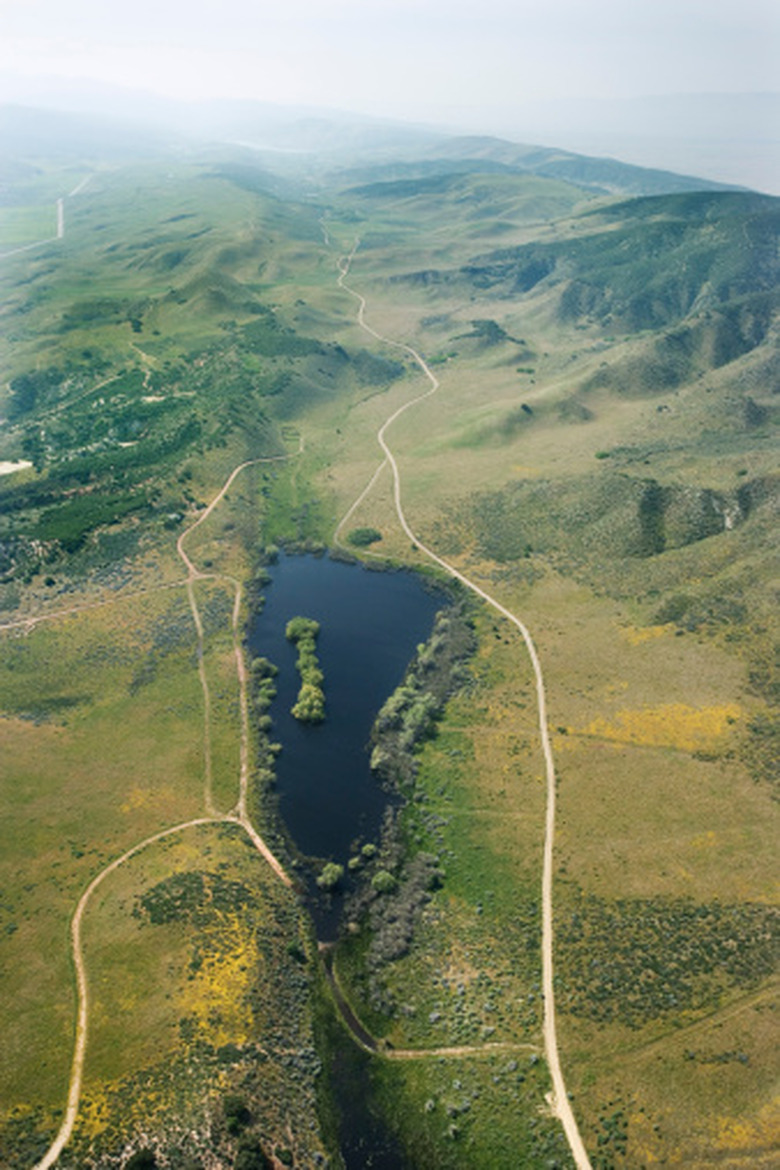What Are Convergent, Divergent & Transform Boundaries?
Convergent, divergent and transform boundaries represent areas where the Earth's tectonic plates are interacting with each other. Convergent boundaries, of which there are three types, occur where plates are colliding. Divergent boundaries represent areas where plates are spreading apart. Transform boundaries occur where plates are sliding past each other.
Oceanic vs. Continental Convergent Boundaries
Oceanic vs. Continental Convergent Boundaries
When oceanic plates collide with continental plates, the denser oceanic plate is forced under the lighter continental plate. This process has three geological results. The continental plate is lifted upwards, creating mountains. As the oceanic plate subducts, a trench is formed. Finally, as the descending plate melts, it leads to volcanic activity on the surface of the continental plate. This is occurring where the oceanic Nazca Plate is subducting under the South American Plate, creating the Andes Mountains and the Peru-Chile Trench.
Oceanic vs. Oceanic Convergent Boundaries
Oceanic vs. Oceanic Convergent Boundaries
When two oceanic plates collide, the older denser plate subducts or "dives" underneath the other plate. The results of this tectonic collision are similar to those involving oceanic and continental plates. A deep trench is formed on the seafloor. For example, the formidable Marianas Trench has been formed by the subduction of the Philippine Plate under the Pacific Plate.
Undersea volcanic activity also occurs when two oceanic plates converge on one another. Over time, this activity can even form new island chains. The Aleutian Peninsula in Alaska is an example of this type of island arc.
Continental vs. Continental Convergent Boundaries
Continental vs. Continental Convergent Boundaries
When continental plates collide into one another, neither plate can subduct under the other because they are equally light and buoyant. Instead, they are pressed together under intense pressure. This pressure creates buckling and slipping, both vertically and horizontally.
The buckling of the two plates causes the earth's surface to develop folds and faults, often leading to the development of mountain ranges. In fact, this is the process by which the largest mountains on Earth have been formed. For example, when the Indian and Eurasian Plates collided around 50 million years ago, the result was the formation of the Himalayas and Tibetan Plateau.
Divergent Boundaries
Divergent Boundaries
Divergent boundaries occur where plates are spreading apart or separating from one another. This spreading is caused by convective forces in the molten magma below them. When this occurs between two oceanic plates, as they slowly spread apart, this fluid basalt lava fills the gap and quickly solidifies as the water cools it, forming new oceanic crust.
As this process continues, the activity causes a ridge in the seafloor. An example of an oceanic divergent boundary is the Mid-Atlantic Ridge. Iceland actually sits atop the Mid-Atlantic Ridge. Eventually, the island will be split into two separate landmasses because the plates will continue to move in opposite directions.
When two continental plates pull apart, a rift valley is formed. As the plates separate, faults form on either side and the earth in between sinks. This activity often results in earthquakes. One example of a continental divergent boundary is the East African Rift.
Transform Boundaries
Transform Boundaries
Transform boundaries occur where plates are sliding past one another. They are also called conservative boundaries because crust is neither destroyed nor created along them. Transform boundaries are most common on the seafloor, where they form oceanic fracture zones.
When they occur on land, they produce faults. These fracture and fault lines typically connect offsetting divergent zones. For example, the San Andreas Fault connects the South Gorda divergent zone, north, to the East Pacific Rise, to the south. On the north end, this fault continues out into the Pacific Ocean as the Mendocino Fracture Zone. Along the San Andreas Fault, the Pacific Plate is moving to the northwest and the North American Plate is moving to the southeast.
Cite This Article
MLA
Bennett, Doug. "What Are Convergent, Divergent & Transform Boundaries?" sciencing.com, https://www.sciencing.com/convergent-divergent-transform-boundaries-8606129/. 30 September 2021.
APA
Bennett, Doug. (2021, September 30). What Are Convergent, Divergent & Transform Boundaries?. sciencing.com. Retrieved from https://www.sciencing.com/convergent-divergent-transform-boundaries-8606129/
Chicago
Bennett, Doug. What Are Convergent, Divergent & Transform Boundaries? last modified August 30, 2022. https://www.sciencing.com/convergent-divergent-transform-boundaries-8606129/
